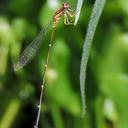United States and Canada
The face of the male is bright orange with a dark black central spot. The top of the head is black with orange spots lateral to each antenna. The antehumeral area is mostl y black with a metallic luster. The middorsal carina and 2/3 of the antealar carina are orange. The mesepimeron is black with orange margins and the mesopleural suture is traversed by a thin black line bordered by a wider orange stripe laterally. The legs are pale, darkening slightly at their apices. The first abdominal segment is black with a narrow pale apical band. Segment 2 is pale orange and segments 3-7 are dark dorsally, each with a pale basal ring. Segments 8-9 are black, each with pale ventrolateral margins and apical rings. Segment 10 is black except for a pale band posterolaterally. The female is stockier, but otherwise similar to the male. The abdomen differs only slightly in coloration. The dorsum of segments 1-2 and 10 are nearly all black and the dark areas of the middle segments are expanded subapically.
Size: Total length: 34-38 mm; abdomen: 27-32 mm; hindwing: 16-19 mm.
Similar Species (south-central US): Male Coral-fronted Threadtails (N. aaroni) and Amerlia's Threadtails (N. amelia) have more orange on the face and top of the thorax. Orange Bluet (Enallagma signatum) is similar but overall paler and the abdomen is not as long. Cherry Bluet (E. concicsum) is deep red and does not overlap in distribution.
Habitat: Well-shaded, slow moving streams with ample leaf litter and debris.
Natural History: This is a relatively uncommon species that has been documented only in a few counties within the Hill Country of central Texas and the lower Rio Grande Valley. A photograph was taken of an ovipositing pair at the Houston Arboretum in 1988. These were probably an accidental introduction with aquatic plants (R. Orr, pers. comm.). They have not been seen there since. Egg laying typically occurs in tandem near the margin of slow-moving water in floating and submerged vegetation and debris. The larva has not been discovered, but based on observations of other related species, it may live in leaf litter of small trickles and pools.
Distribution: Texas; south through Mexico to Guatemala and Honduras.
Source: Abbott, J.C. 2006-2010. OdonataCentral: An online resource for the distribution and identification of Odonata. Available at OdonataCentral.
Edited by Drew Weber (9/24/2015).
